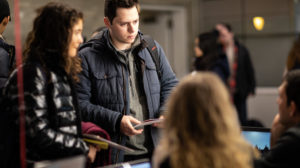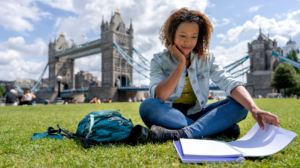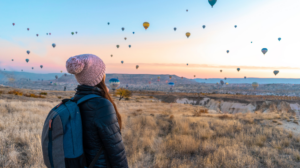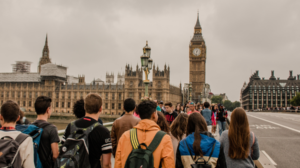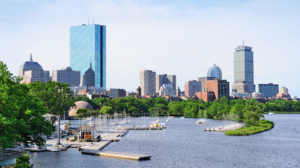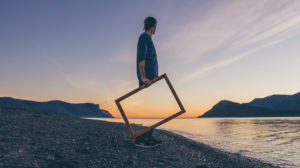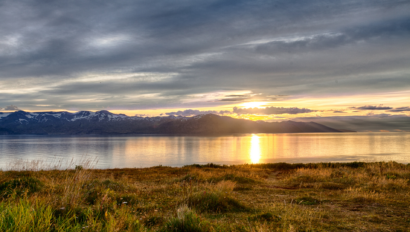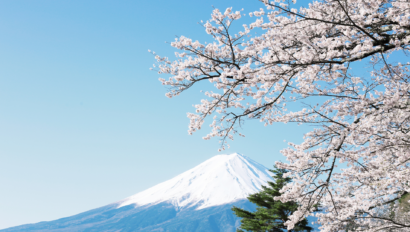1395: 626 years ago. A whole dynasty, colonization, and democratic reform ago.
1395: the year Gyeongbokgung Palace (경복궁)––the largest of five palaces in Korea––was built. Gyeongbokgung reigned during the Joseon Dynasty (1392-1897), a dynasty that majorly shaped Korea’s history and founded the Korean alphabet, hangul.
After being destroyed and restored years later, it is now a popular tourist attraction where people can relive Korea’s history––and typically in the style of a hanbok, traditional Korean clothes.
And, of course, on the day Seoul was hit with sweltering, humid 90ºF weather, my friends and I chose to venture to the palace. But first: food. We took the bus to Samcheongdong Sujebi, a Michelin-star restaurant serving sujebi, a hand-pulled dough soup perfect for the winter––or I guess in this case, summer.
The exterior of the restaurant was almost hidden––like a hole-in-the-wall restaurant you would easily pass by in the street. Walking in, we immediately witnessed a bustling crowd of local Koreans chowing down on their soup; we knew that we hit the jackpot.
A waitress escorted us to our table covered by blinds, gesturing to us to take our shoes off before sitting down. We sat in a kneeling posture on top of flat pillows, awaiting our order: four bowls of sujebi and one pajun (green onion Korean pancake).
The first thing we asked the waitress: “Is this for four people?” The waitress had set down a ginormous black pot––which almost looked like a cauldron––in the center of the table; definitely not the four individual pots that we expected. After explaining that the dish contained four servings, we grabbed the ladle and poured our individual plates.
It was the best sujebi I’d ever tasted. The sujebi itself was perfectly chewy and soft, and the soup wasn’t too greasy or too bland. It definitely didn’t fail to remind us as to why this restaurant deserved its Michelin stars.
The pajeon was also absolutely delicious. The green onion was perfectly integrated within the pancake and was the perfect side to compliment the soup. Even though I’ve been in South Korea for several weeks now, I haven’t tried as much traditional Korean food––and I’m extremely glad that this was one of my first dishes. It made the trip to the palace all the more meaningful: the fact that I was able to try traditional food that truly reflected the culture.
After filling our stomachs with the sujebi, we instantly traveled to the hanbok rental store, where you can rent traditional clothing from a wide variety of choices. My friend chose out a pastel pink butterfly skirt for me, and the employee immediately found a pastel top with laced sleeves and a pink ribbon to compliment the bottom wear.
The employees helped each of us change into our hanboks and offered to style our hair for an extra 3000 won. They braided our hair and lined it with small pearls, attaching a daenggi (댕기)––a traditional hair ribbon––at the end of our tied hair. We picked up a traditional bag as well to officially complete the outfit.
All fitted into our traditional wear, we strutted outside the hanbok store, approaching the palace. And trust me, I haven’t forgotten about the weather, which almost seemed to be weighing even heavier on our shoulders after changing.
Several guards acting as Wanggung Sumunjang (왕궁수문장)––the name for Palace Guards during the Joseon Dynasty––stood firmly in front of the Gwanghwamun Gate (광화문) that separates the palace from the outside world. Dressed in embroidered red clothing and a round black hat, they stood still as they ensured that the palace was kept supervised.
Gyeongbokgung Palace includes a small admission fee for visitors but excludes it for those wearing hanboks. We strolled into the palace with our hanboks, bewildered by the tall palace buildings that hosted significant, historical rooms for the King like his library and quarters.
On the west side of the palace sits the Gyeonghoeru Pavilion, situated on top of a winding pond surrounded with splashes of green trees. The pavilion commonly hosted feasts with foreign envoys or court officials led by the King.
After a few hours, my friends and I completed our rounds of the palace and walked back to the hanbok store, ready to return to civilization. Dressing out of our traditional clothes, we decided to combat the beating sun with bingsoo, Korean shaved ice, at Bukchon Bingsu. The green tea and mango bingsoo we ordered were perfect to cool us down. Each “snowflake” was packed with condensed milk, assuring us a flavorful experience with every bite.
My friends and I explored Han River, another tourist attraction on our list, the river that divides the northern and southern part of South Korea. When it comes to food, Han River is famous for its convenience store ramen. All you have to do to taste this instant food goodness is head over to the local MiniStop, pick any ramen brand of your choice, and exit the store to find an instant ramen cooking bar.
Once you place your ramen in a tin bowl, you can lift it up onto an electric stove. The above machine pours water into the tin, and the machine takes care of the rest of the process. After it alerts you when the noodles are done, you can finally enjoy your instant meal.
We then walked along the borders of the river, watching bikers zip pass by us and tons of seagulls flapping by. The day ended off with a beautiful sky mixed with colors of orange, red, and yellow.
This week was a week of historical landmark exploration––and I couldn’t have been happier that I took part in it. It definitely reminded me of the significance of Korean’s history, and I’m looking forward to learning more in the upcoming weeks.

